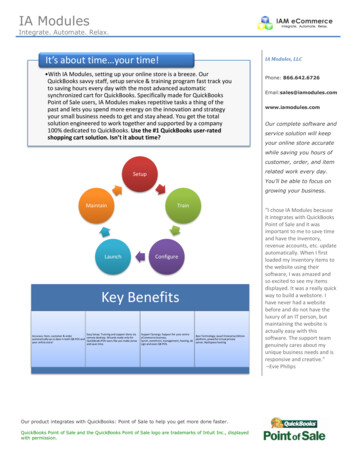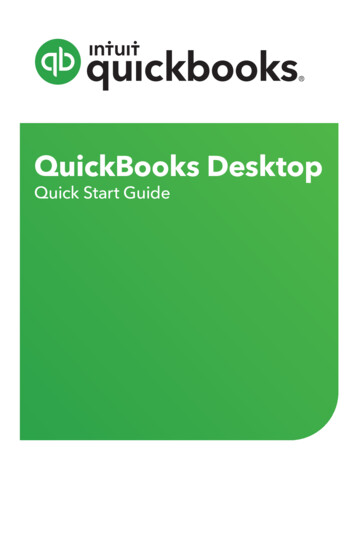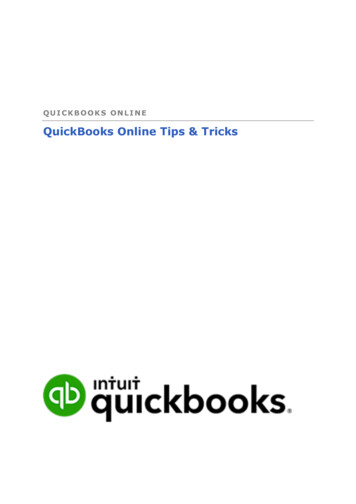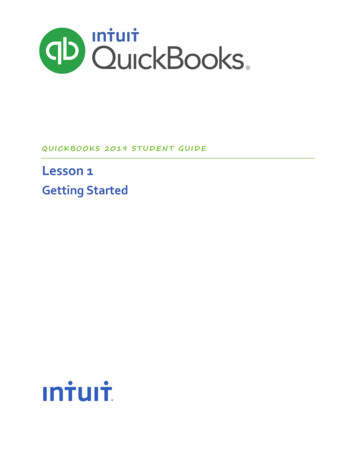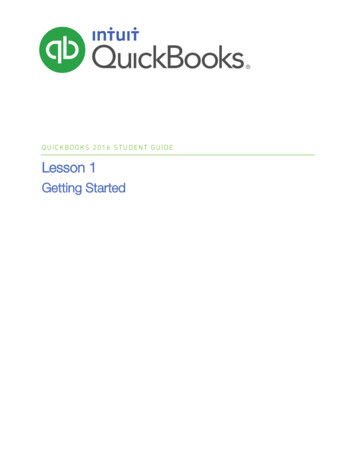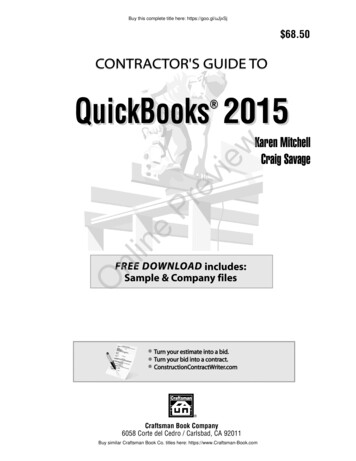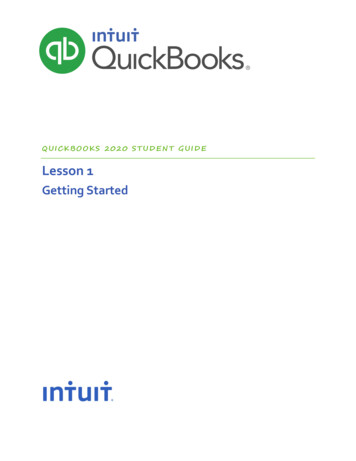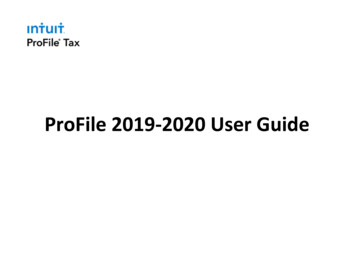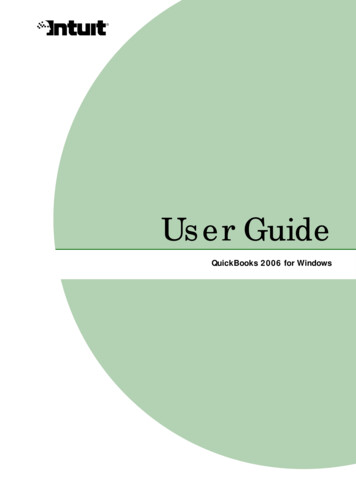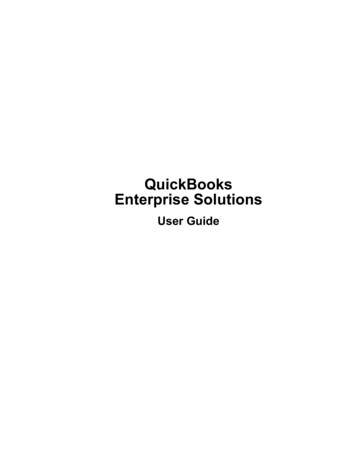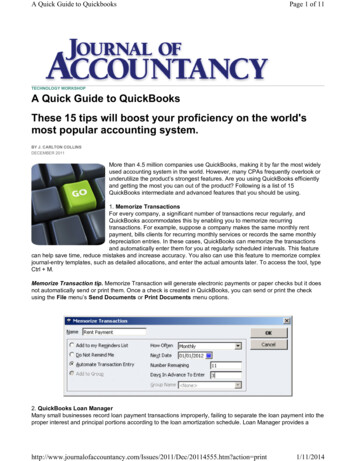
Transcription
A Quick Guide to QuickbooksPage 1 of 11TECHNOLOGY WORKSHOPA Quick Guide to QuickBooksThese 15 tips will boost your proficiency on the world'smost popular accounting system.BY J. CARLTON COLLINSDECEMBER 2011More than 4.5 million companies use QuickBooks, making it by far the most widelyused accounting system in the world. However, many CPAs frequently overlook orunderutilize the product’s strongest features. Are you using QuickBooks efficientlyand getting the most you can out of the product? Following is a list of 15QuickBooks intermediate and advanced features that you should be using.1. Memorize TransactionsFor every company, a significant number of transactions recur regularly, andQuickBooks accommodates this by enabling you to memorize recurringtransactions. For example, suppose a company makes the same monthly rentpayment, bills clients for recurring monthly services or records the same monthlydepreciation entries. In these cases, QuickBooks can memorize the transactionsand automatically enter them for you at regularly scheduled intervals. This featurecan help save time, reduce mistakes and increase accuracy. You also can use this feature to memorize complexjournal-entry templates, such as detailed allocations, and enter the actual amounts later. To access the tool, typeCtrl M.Memorize Transaction tip. Memorize Transaction will generate electronic payments or paper checks but it doesnot automatically send or print them. Once a check is created in QuickBooks, you can send or print the checkusing the File menu’s Send Documents or Print Documents menu options.2. QuickBooks Loan ManagerMany small businesses record loan payment transactions improperly, failing to separate the loan payment into theproper interest and principal portions according to the loan amortization schedule. Loan Manager provides ec/20114555.htm?action print1/11/2014
A Quick Guide to QuickbooksPage 2 of 11solution that enables you to set up each loan with its associated parameters, such as term, rate, fees,compounding, balloon payments, etc. Thereafter, Loan Manager will generate the correct loan payment checkeach payment period, once again saving time, reducing mistakes and increasing accuracy. To access the tool, goto the Banking menu, Loan Manager.3. Process Multiple ReportsOften, bookkeepers who do a good job of keeping the books fail to consistently produce and distribute thenecessary financial reports each day, week or month for company personnel to use in managing the business. Inmany cases, the process of preparing and printing dozens of reports is too time-consuming. QuickBooks providesa solution called Process Multiple Reports, which enables users to group together dozens of reports (using theMemorize function) and print them all in a single step, as shown below. To access the tool, go to the Reportsmenu, Process Multiple Reports.Multiple Reports tips. When memorizing each report, include the recipient’s name in the report title to makedistribution a little easier. In addition, re-sorting the reports in the Memorize Report window will ensure that thereports print in collated order.4. Prevent Prior-Period ChangesA common issue with QuickBooks is how easily users can (intentionally or unintentionally) enter or edittransactions in prior periods. To prevent unauthorized prior-period entries or changes, set up a unique usernameand password for each user and set each user’s preferences to prohibit him or her from bypassing the closingdate. Thereafter, by establishing a password-protected closing date and moving it forward each month as reviewand adjustments are completed, you can lock down the prior-period data as the year progresses, as shown in thescreenshot at the bottom of the previous page. To access the tool, go to the Company menu, Set Closing 11/Dec/20114555.htm?action print1/11/2014
A Quick Guide to QuickbooksPage 3 of 115. Custom Data FieldsI often have found custom fields to be one of the most powerful features in accounting software. QuickBooksPremier provides 20 generic custom data fields, and QuickBooks Enterprise provides more than 50 contentspecific custom data fields. Using these data fields, a clever CPA can overcome many shortcomings in anaccounting system. For example, a boat marina might use custom fields to track the name of the customer’s boatand slip number and to create a data field indicating whether the customer subscribes to the monthly crankingservice (see screenshot below).Further, QuickBooks allows users to filter reports using those custom data fields. For example, the boat marinacould filter a list of customers to display only those who subscribe to the monthly cranking service, therebyproducing a list of boats that need cranking each month. To use the tool, go to the Customer Center, select aCustomer, click the Edit Customer button, then under the Additional Information tab, click Define Fields.Custom Data tip. Information entered into custom data fields can also be included in financial reports, oninvoices and in all QuickBooks es/2011/Dec/20114555.htm?action print1/11/2014
A Quick Guide to QuickbooksPage 4 of 116. Batch InvoicingQuickBooks versions 2011 and higher enable users to create a batch of invoices in a single process. Forexample, a company that needs to invoice 500 customers each month for a 20 Webhosting fee can generate all500 invoices in one step. The batch invoice feature also allows users to search for customers according to customdata fields and then invoice the resulting group. For example, this would empower the boat marina’s bookkeeper(as mentioned above) to invoice in a single step each customer who subscribes to the monthly cranking service.To access the tool, go to the Customers menu, and select Create Batch Invoices (see screenshot atop the nextcolumn).7. Editing TemplatesInvoices, sales orders, purchase orders, customer statements and other documents are referred to as templatesin QuickBooks. These templates can be edited by rearranging the document and by adding additional columns,data fields, text, images and custom data fields. For example, it may be beneficial to edit the company’s invoicetemplate to include the sales representative’s name and phone number, additional columns for quantity and rate,or back-order information in the event of partial shipments. A knowledgeable user will review the templates andenhance them in an effort to best meet the company’s needs. To access the tool, go to the Lists menu,Templates, right-click on a template and select Edit Template, then click the Layout Designer button.Templates tip. The templates screen provides an option for downloading additional templates from the Web, aswell as colorful themes for enhancing all of your es/2011/Dec/20114555.htm?action print1/11/2014
A Quick Guide to QuickbooksPage 5 of 118. Remote AccessQuickBooks Remote Access is a Web-based service (go to tinyurl.com/m7ljuf) that allows CPAs to securely log into their clients’ QuickBooks systems. Remote Access grants the CPA entry only to the client’s QuickBooksapplication and data and prevents the CPA from viewing other data, such as Word, Excel and email files, on theclient’s computer. The service takes only a few minutes to set up and, thereafter, the CPA can log in to the client’sQuickBooks to train users, review the client’s books and, if appropriate, enter corrections and adjustments.In my experience, using Remote Access is a better solution than using the QuickBooks Accountant’s Copymethod, for several reasons. First, the CPA avoids the need to have the client’s edition of QuickBooks running.Second, the CPA and client do not have to send the Accountant’s Copy files back and forth. Third, RemoteAccess provides full access to the client’s data in real time. Further, Remote Access makes it easier for the CPAto provide monthly and on-demand services throughout the year. In contrast, the Accountant’s Copy approachoften leads the CPA to be involved with the client’s books only at yearend. (Note: Remote access is pricedstarting at 3.95 per month.)Remote Access tip. This type of remote access gives the CPA control of the client’s screen, allowing the client tosee the CPA’s mouse actions as the client is trained remotely via the telephone.9. Stratifying ReportsQuickBooks provides a Columns tool that can stratify financial reports by numerous column configurations. Thisfunctionality is valuable for analyzing and scrutinizing a company’s financials. For example, a single column profitand-loss statement can be quickly transformed into an 81-column profit-and-loss statement—with a separatecolumn for each of 80 customers and a total column at the end. Likewise, that same report could be restratified todisplay a column for each inventory item, thereby reporting the profit (or loss) for each item (or group of items).Other options include stratifying columns by month, quarter, year, departments, sales representatives and more(see screenshot below). Surprisingly, many popular, high-end accounting systems and enterprise resourceplanning applications fail to provide this type of beneficial reporting. To access the Columns tool in any financialreport, click on the Columns dropdown menu above the 2011/Dec/20114555.htm?action print1/11/2014
A Quick Guide to QuickbooksPage 6 of 1110. Using Account NumbersAs an option, QuickBooks allows you to display seven-digit account numbers in addition to 31-digit alphanumericaccount names. The benefits are faster data entry (using a 10 key) and the ability to control the sort order ofaccounts displayed in financial reports. For example, you could use this feature to dictate that the accumulateddepreciation account appears below property and equipment, not above. To use the tool, go to the Edit menu,Preferences, Accounting, Company Preferences tab, and check the Use account numbers box, as shownbelow.However, activating this option also includes account numbers in the financial statements and reports, which isnot always desirable. To suppress account numbers, edit each account and add an account description, then setthe Reports-Show Accounts by preference to Description Only. After that, only the account descriptions,instead of account numbers and names, will appear on all financial statements.Reporting tip. The “Description Only” preference setting can be used to display customized row descriptions onfinancial statements; for example, you may prefer “Trade Receivables” instead of “Accounts Receivable.”11. Fixed Asset ManagerEvery company has assets, and the QuickBooks Fixed Asset Manager (included in the Accountant and Enterpriseeditions) can track those assets according to six methods (federal, state, book, adjusted current earnings,alternative minimum tax and other). The system incorporates many tax methods, such as the accelerated costrecovery system, the modified accelerated cost recovery system, and the IRC Sec. 168(f)(1) and Sec. 179depreciation methods, among others. Upon asset dispositions, the system can calculate the appropriate gain orloss on sales, as well as the appropriate amounts of depreciation recapture. Although fixed-asset data can beintegrated with QuickBooks, many companies tend to use the Fixed Asset Manager as a stand-alone product—which I recommend because the effort setting up integration probably takes more time than it saves during theyear—and enter manual depreciation entries each month in QuickBooks. To access the Fixed Asset Manager, goto the Accountant menu, Manage Fixed 2011/Dec/20114555.htm?action print1/11/2014
A Quick Guide to QuickbooksPage 7 of 1112. Attach DocumentsThe Attach Documents feature enables you to attach electronic documents throughout QuickBooks to achieve apaperless environment. As documents are processed, you can save them locally on your computer network or toa cloud-based storage facility accessible by all users, even those in remote locations. Some of the advantages tomaintaining a paperless accounting system are:a. Electronic documents can be available to all users, even remote users;b. You can locate electronic documents quickly via indexed searching;c. Electronic documents are easier to include when preparing reports or email messages, reducing thecosts associated with making copies and sending paper documents;d. Electronic documents can be easily backed up off-site for better data protection; ande. Electronic documents reduce costs related to paper documents such as filing cabinets, file rooms andarchiving efforts.There used to be a charge associated with this feature, but the new QuickBooks 2012 Pro offers AttachDocuments with free local storage, as Intuit is phasing out the cloud option. To use the tool, click the Attachbutton with the paper clip icon in any document or template. This option is grayed out until setup is completed.13. Imported Credit Card TransactionsTyping a lengthy credit card statement into your accounting system is time-consuming and difficult to accomplishwithout making transposition or keypunching errors. By contrast, in most cases, credit card transaction data canbe imported directly into QuickBooks in just a few seconds, and QuickBooks’ built-in logic can automatically matchthe expenditures with the appropriate vendor and account number for more efficient processing. This feature isincluded for free. To access, go to the Banking menu, Enter Credit Card Charges and click the DownloadCredit Card Charges option at the top of the page. Your specific setup and monthly procedures will varydepending on the credit card company you use.14. Intuit Data ProtectNew as of QuickBooks 2011, Intuit’s Data Protect service automatically backs up your QuickBooks data (or al
15.05.2014 · Fixed Asset Manager Every company has assets, and the QuickBooks Fixed Asset Manager (included in the Accountant and Enterprise editions) can track those assets according to six methods (federal, state, book, adjusted current earnings, alternative minimum tax and other). The system incorporates many tax methods, such as the accelerated cost
